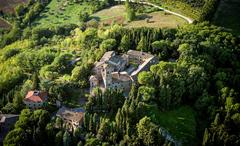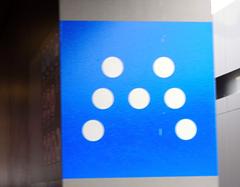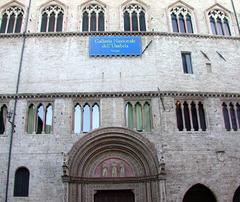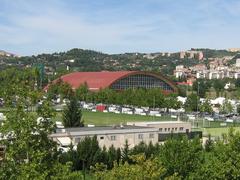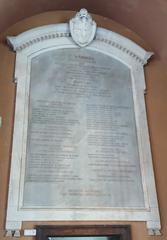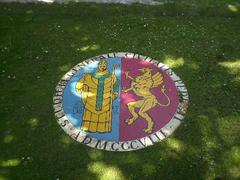Museo Archeologico Nazionale dell’Umbria: Visiting Hours, Tickets, and Complete Guide to Perugia’s Historical Sites
Date: 04/07/2025
Introduction
Situated in the heart of Perugia, the Museo Archeologico Nazionale dell’Umbria (MANU) is a cornerstone of the region’s archaeological and cultural landscape. Housed in the 13th-century San Domenico complex, MANU offers an immersive journey through Umbria’s prehistoric, Etruscan, and Roman pasts. This in-depth guide provides essential information on the museum’s history, visiting hours, ticketing, accessibility, top exhibits, and tips for exploring Perugia’s nearby historical sites, ensuring a memorable and enriching experience for every visitor (Umbria Cultura; Lonely Planet; Exploring Umbria; Umbria Tourism).
Table of Contents
- Introduction
- History and Significance
- Museum Architecture and Setting
- Collections and Highlights
- Visitor Information
- Museum Experience
- Nearby Attractions
- Practical Tips and FAQs
- Visuals and Interactive Content
- References
History and Significance
From Dominican Convent to Archaeological Beacon
The Museo Archeologico Nazionale dell’Umbria is housed within the monumental San Domenico complex, originally a 13th-century Dominican convent. Following Italy’s unification, the site was nationalized and transformed into a museum in 1948, consolidating the region’s archaeological treasures under one roof (Lonely Planet; Exploring Umbria).
The museum plays a vital role in preserving and interpreting Umbria’s ancient history, offering insights into the region’s prehistoric, Etruscan, Umbrian, and Roman cultures.
Museum Architecture and Setting
The MANU is located at Piazza Giordano Bruno 10, within Perugia’s historic center, just outside the ancient Etruscan walls (Umbria Tourism). Its adaptive reuse of the former Dominican convent preserves the building’s architectural integrity while creating evocative spaces for exhibitions. The cloister, accessible to the public without a ticket, is lined with funerary urns and cippi dating from the Hellenistic period, setting the tone for the archaeological journey within.
Collections and Highlights
Prehistoric and Protohistoric Artifacts
The museum’s itinerary begins with artifacts from the Paleolithic to Bronze Ages. Stone tools, ceramics, and burial objects trace the evolution of human settlement in Umbria, offering a window into the lives and technologies of its earliest inhabitants (Exploring Umbria).
Etruscan and Umbrian Treasures
The Cippo Perugino
A remarkable highlight is the Cippo Perugino, featuring the longest known Etruscan inscription. Discovered in 1822, this artifact provides invaluable insights into Etruscan language and society (Lonely Planet).
Necropoleis and Funerary Art
The museum’s Etruscan and Umbrian collections are renowned for their funerary urns, sarcophagi, and grave goods from necropoleis such as Monteluce and Crocefisso del Tufo. The reconstructed Tomb of the Cai Cutu family and the Sperandio Sarcophagus are must-see exhibits, providing a vivid sense of ancient burial customs and beliefs (Exploring Umbria).
The Cacni Tomb
A more recent addition, the Cacni Tomb (3rd–2nd century BC), discovered in 2003, showcases travertine urns and grave goods influenced by Greek iconography, reflecting the cultural exchanges of the period.
Roman Period Objects
The museum’s Roman section features mosaics, inscriptions, sculptures (including a marble telamon), and everyday items. Highlights include objects related to the rebirth of Perugia (Perusia Restituta) after the Perusine War, illustrating the city’s transformation under Roman rule (Exploring Umbria).
Numismatic and Amulet Collections
The Bellucci Collection is a unique assembly of amulets and talismans, revealing ancient beliefs and superstitions. The extensive numismatic cabinet displays coins and monetary treasures spanning several centuries, while goldsmithery exhibits highlight the artistic achievements of Umbrian and Etruscan artisans.
Visitor Information
Visiting Hours
- Tuesday–Sunday: 8:30 AM – 7:30 PM
- Monday: 10:00 AM – 7:30 PM
- Closed: January 1st and December 25th (Nomads Travel Guide)
Hours may vary on holidays or during special events. Always confirm on the official website.
Ticketing and Admission
- Standard ticket: €5
- Reduced: Available for students, seniors, and groups
- Free entry: Children under 18; first Sunday of every month (“Domenica al Museo”) (Musei Blog)
- Special exhibitions: Ticket prices may vary
Tickets can be purchased onsite or in advance online.
Getting There & Accessibility
- Address: Piazza Giordano Bruno 10, Perugia, Italy
- By public transport: Nearest bus stop: Tre Archi (200 meters away) (Umbria Tourism)
- By car: Parking for visitors with disabilities is available; call in advance for direct access to the cloister.
- On foot: The central location makes the museum easily accessible from major city sites.
Accessibility Features
- Wheelchair access with ramps and elevators
- Adapted restrooms and seating areas throughout
- Cloakroom available for bags and coats
- Assistance for visitors with reduced mobility; contact the museum ahead for special arrangements
Guided Tours and Educational Programs
- Guided tours: Offered in Italian, with English available upon request (WhichMuseum)
- Audio guides: May be available for rent
- Workshops: Family and school-friendly educational programs
- Special events: Temporary exhibitions and themed tours throughout the year
Travel Tips
- Duration: Allocate 2–3 hours for a complete visit
- Best times: Weekday mornings are quieter; free-entry Sundays can be busy
- Photography: Allowed without flash, except in marked areas
- Language: Most labels are in Italian; use translation apps or request English guides if needed
Museum Experience
Layout and Exhibition Design
MANU’s exhibitions are organized thematically and chronologically, guiding visitors from prehistory through the Roman era. Recent renovations have enhanced accessibility and interactivity, with clear bilingual signage and well-lit galleries (Artsupp).
Interactive and Educational Features
- Digital reconstructions and multimedia displays
- Thematic reconstructions, such as the Cai Cutu Tomb
- Interactive maps and virtual tours available via the official website
Nearby Attractions
The museum’s central location makes it easy to combine with other Perugia sites:
- Galleria Nazionale dell’Umbria: Masterpieces of Umbrian art
- Collegio del Cambio: Frescoes by Perugino
- Rocca Paolina: Historic underground fortress
- Hypogeum of the Volumnus Family: Etruscan burial site
- Museo Civico di Palazzo della Penna: Contemporary art and city history
Practical Tips and FAQs
Frequently Asked Questions
Q: What are the Museo Archeologico Nazionale dell’Umbria visiting hours?
A: Tuesday–Sunday: 8:30 AM–7:30 PM; Monday: 10:00 AM–7:30 PM. Closed January 1st and December 25th.
Q: How much are tickets?
A: Standard admission is €5; free on the first Sunday of each month.
Q: Is the museum accessible?
A: Yes, there are ramps, elevators, and facilities for visitors with reduced mobility.
Q: Are there guided tours in English?
A: Guided tours are primarily in Italian; English tours may be arranged upon request.
Q: Can I take photos?
A: Non-flash photography is allowed except where indicated.
Q: What other sites are nearby?
A: The Galleria Nazionale dell’Umbria, Collegio del Cambio, Hypogeum of the Volumnus Family, and Rocca Paolina are all within easy reach.
Visuals and Interactive Content
- High-quality images of the museum’s façade, Cippo Perugino, reconstructed tombs, and the Bellucci Collection are available on the official site, with alt tags such as “Etruscan artifacts at Museo Archeologico Nazionale dell’Umbria” and “Historic cloister of MANU in Perugia.”
- Virtual tours and interactive maps enhance the visitor experience and are accessible online (Official Website).
References
- Umbria Cultura
- Lonely Planet
- Exploring Umbria
- Umbria Tourism
- Nomads Travel Guide
- Artsupp
- WhichMuseum
- Musei Blog
- In Perugia Today
Final Recommendations
The Museo Archeologico Nazionale dell’Umbria is an essential stop for anyone seeking to uncover the ancient roots of Perugia and the broader Umbrian region. With its rich collections, educational programs, and accessible facilities, the museum offers an enriching experience for scholars, families, and travelers alike. For the best experience, plan your visit in advance, explore the cloister’s open-air displays, and take advantage of interactive resources and guided tours.
Stay updated on opening hours, events, and exhibitions by visiting the official website or downloading the Audiala app. For further inspiration, explore our related articles on Perugia’s historical sites and Umbrian culture.
